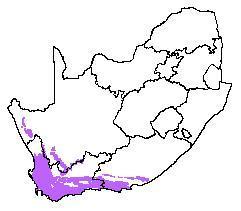RENOSTERVELD
Renosterveld

Renosterveld is characterized by the dominance of members of the Daisy Family (Asteraceae), specifically one species - Renosterbos Elytropappus rhinocerotis, from which the vegetation type gets its name. Although Renosterbos is the characteristic dominant, many other plants are also prominent - for instance in the Daisy Family (Asteraceae): Eriocephalus, Felicia, Helichrysum, Pteronia, Relhania; Pea Family (Fabaceae): Aspalathus; Gardenia Family (Rubiaceae): Anthospermum; Cocoa Family (Sterculiaceae): Hermannia; Thymelea Family (Thymelaeaceae): Passerina. All these shrubs are characterized by their small, tough, grey leaves.
Grasses are also abundant. In fact, it is alleged that the high shrub cover is a result of continuous grazing. Early records suggest that the Renosterveld had abundant grasses, and that the game and Khoi cattle migrated over the region. With the establishment of European stock farmers, continuous grazing and the elimination of the diverse grazing-browsing fauna, the shrubby element was promoted. This theory is not universally accepted, but proponents argue to the sudden decline of hay near Cape Town in the early 1700's, and the many historical records of early explorers claiming that Renosterbos was taking over and that grass was becoming scarce.
Another feature of Renosterveld is the high species richness of geophytic plants (chiefly in the Iris Family (Iridaceae) and Lily Family (Liliaceae), but also in the Orchid Family (Orchidaceae)).
Proteas, Ericas and Restios - typical of Fynbos - tend to be absent in Renosterveld, or are present at very low abundances. There are few endemics to Renosterveld vegetation alone, many of the species occurring in Fynbos as well. However, species endemic to the Cape Floral Kingdom comprise about one-third of Renosterveld plant species, and many of these belong to families which are not considered to be of "Cape affinity" (ie. these families are also diverse outside the Cape Floral Kingdom).
Typically, Renosterveld is largely confined to fine-grained soils - mainly clays and silts - which are derived from the shales of the Malmesbury and Bokkeveld Groups and the Karoo Sequence. In drier regions it also occurs on Cape Granite Suite-derived soils. Because all these soils are fertile, much of Renosterveld has been ploughed for wheat.
Renosterveld tends to occur where rainfall is between 250 (rarely to 200 mm) to 600 mm per year and at least 30% fails in winter. Where the rainfall is higher, the soils become leached and Renosterveld is replaced by Asteraceous Fynbos. Generally, where the rainfall is less than 250 mm it is replaced by one of the Succulent Karoo vegetation types.
Because of its high soil fertility, it is probable that all the herds of large game in the Fynbos Biome occurred in Renosterveld. Thus Mountain Zebra, Quagga, Bluebuck, Red Hartebeest, Eland, Bontebok, Elephant, Black Rhino and Buffalo were common, as were Lion, Cheetah, Wild Dog, Spotted Hyena and Leopard. Two of these only ever occurred within the Fynbos Biome: Bluebuck and Bontebok. Of these large mammals, only the Mountain Zebra and Leopard survived (by fleeing to the mountains), with the Bontebok just surviving near Bredasdorp. All the other species became extinct in the Fynbos Biome (one elephant survives in the Forest Biome within the Fynbos Biome area), although many have been introduced into conservation areas from outside the region. The Quagga and Bluebuck are extinct.
This high fertility has meant that most of the area has been converted to agriculture. Less than 5% of West Coast Renosterveld remains (the Rio Convention has as its goal the preservation of 1 0%!), with other Renosterveld types also heavily ploughed or used as augmented pasture. It seems unlikely that viable populations of large mammals will ever be reintroduced into the Fynbos Biome for this reason.
The conservation status of this region has been the focus of several symposia and workshops, which have seen lots of hot air and schemes but little actual conservation on the ground.
Source: Low, A.B. & Rebelo, A.(T.) G. 1998. Vegetation of South Africa, Lesotho and. Swaziland, edn 2. Dept of Environmental Affairs and Tourism, Pretoria.





Comments
Add a Comment